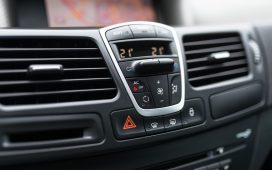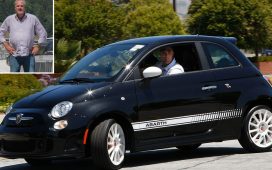1 – Diversity of models and brands is both a blessing and a curse
The first afternoon after touching down in Beijing was an electric mobility revelation. All the electric models and brands we at electrive report about daily are already on the road here. And not just the occasional one, as is the case in Germany. But in multitudes. I was really impressed. It’s one thing to write about it in theory – and another to experience it up close. The amount of electric vehicles also helps reduce the background noise on the vast roads. Whereas in Germany (and other European countries), the diesel engines roar from red light to red light, in Beijing, there is a constant but not disturbing background noise – interrupted only by honking at the congested junctions. But back to the diversity: my well-trained eye could hardly tell the many Chinese electric cars apart. Was that a BYD or an SUV from Xpeng? Did an Arcfox whizz past, or was it a Wey?
It’s no wonder that newcomer (and trade fair favourite) Xiaomi uses bright colours to stand out among the design uniformity of China’s electric vehicles. I also recognised Tesla and the (hardly electrically present) German brands more easily, which may also be due to my background. The first newcomers, such as Zeekr, a brand from the Geely Group, realised that they needed to stand out from the crowd and be sought after. Western manufacturers can also score points here with their long-term design and brand strategies.
2 – In China, it’s not about hardware, but about software
If you drive a car in China, you don’t actually drive. That’s why BMW’s slogan “The joy of driving” hardly works here. You roll along in an unbelievable avalanche of cars, rather leisurely – and often not at all. Eight kilometres from a hotel to a press event can take 30 minutes. Anyone who experiences this also understands why all the screens and connectivity features are so important in China. Passengers, in particular, spend most of their time on screens – after all, they are constantly glued to their smartphones outside the car. In China, daily life is organised digitally. We order food and pay in all the shops using Alipay or WeChat. And people are entertained and exposed to sound around the clock. This digital lifestyle is finding its way into the car because it takes forever to get to your destination – so you have time for entertainment or communication.
Anyone who thinks they might as well stop driving and take the bus has not reckoned with the Chinese. Because those with money actually prefer to stand behind darkened windows in traffic jams and enjoy digitally entertained privacy on four wheels instead of taking the bus, train or bike. Accordingly, the discussions at the trade fair did not centre on charging curves or ranges. Some manufacturers were extremely stingy with technical details. You just buy the battery that BYD or CATL are currently supplying. None of this is decisive. “But look at this display here!” The car of the future will soon be able to navigate its way through traffic jams autonomously. Voice control of the many features is much more important. And the progress is impressive, as the Large Language Model in the JIYUE 01 showed me.
3 – China has the edge in battery technology and production
It was early afternoon when CATL invited me to the presentation of its new Shenxing Plus. The battery giant is one of the very few suppliers to have its own stand in the exhibition halls between the vehicle brands. The car parts actually have their own exhibition area. If I hadn’t shown my email invitation at the last second, I wouldn’t have been able to get into the seating area of the stand without the necessary QR code in the WeChat app. A device for translating into English is also not considered necessary here. So, I can only follow the slides and cover my ears as best I can. And to follow the body language of the CATL representatives, who are bursting with dominance and self-confidence. Their volume is deafening. The fact is that the battery giant is making progress at a remarkable pace, having increased the energy density of its LFP cells to 205 Wh/kg within eight months – and at the system level. The self-confident slogan “The speed of innovation determines who is the leader in the industry” is emblazoned on a slide.
It is not expected that this pace will slow down. On the contrary, similar to the solar industry, the foundations for the breathtaking development of battery technology have been laid in China. Wherever relevant manufacturers (such as CATL near Erfurt, Germany, or BYD in Hungary) are setting up their factories, these advances will sooner or later be transferred to series production. It is far from certain that PowerCo and Northvolt will be able to keep up with this momentum, even if it would be desirable. However, European companies may score points with more sustainable production, even if they already lose out on price and speed. That seems to me to be the only advantage at the moment. The question will be whether customers will favour sustainability or if regulators will impose rules so that the European battery industry even stands a chance against the Chinese superiority.
4 – Adapting to Europe costs Chinese manufacturers time and money
There is almost no manufacturer premiere at the China International Exhibition Centre Shunyi that is not looking to export. Anyone who does not already sell EVs in Europe, like BYD, wants to get there as quickly as possible. Zeekr will launch in Germany this autumn (according to high-ranking representatives at the Geely Media Drive on the sidelines of Auto China). And even Hongqi, the manufacturer of Chinese state cars, wants to export respectable electric vehicles to Europe in a few years. That is because the CO2 targets in the EU are creating an exciting market – and the further path to reducing emissions (there is no ban on combustion engines, even if conservative politicians like to claim there is!) is predetermined and can thus be translated into calculable plans. However, in many conversations, I have heard that Chinese newcomers are still struggling to meet the higher vehicle safety requirements that apply in Europe.
In China, a new electric car is quickly developed and produced in one of the many factories. But – see point 1 – it just has to roll around comfortably in the megacities. In Europe, on the other hand, there are different requirements – partly from customers, partly from the authorities. In fact, the German motorway without speed limits is a barrier to market entry. No Chinese manufacturer can afford a poor Euro NCAP result. And that is why armies of engineers are busy fulfilling Europe’s requirements. It is unlikely that the newcomers will be deterred by the motorway barrier. But they will have to spend time and money to make their electric cars Europe-compatible. And it makes Chinese electric vehicles more expensive. That offers local manufacturers at least a small window of opportunity to get their own electric cars on the road. Of course, there is no guarantee that all Chinese newcomers will survive the ruinous price war. Promising players such as Byton have already had to give up, and Xpeng and Nio are posting huge losses. In the end, “only” large corporations such as Geely and BYD may survive with their EV brands in China. However, nobody in Europe can afford to hesitate!
5 – A feel-good electric mobility ecosystem as an opportunity
And that brings us to the slowdown in the buying mood for electric cars in Germany. In the run-up to the European elections, electric mobility is being written off by right-wing and conservative parties alike. Meanwhile, voters are promised that the combustion engine will prevail and be cleaned up with synthetic fuels. Let me be clear: both ideas are rubbish! The path is clear: electric mobility is coming. In Germany and in Europe, too. Whether it takes two or five years longer is irrelevant. The decisive factor is whether the European automotive industry stays in the game long-term – or falls under the (Chinese) wheels.
This could be achieved with a much stronger focus on a fully integrated ecosystem that functions conveniently and offers real added value. Or at least outweigh the still apparent disadvantages compared to the combustion engine. After the technology-loving early adopters, the next customer groups simply want to drive from A to B. They want to charge their vehicles without having to fiddle with charging cards or apps, scan QR codes or enter their credit card details on mobile websites. That is why the mandatory credit card terminal for European charging stations is a good idea, even if it annoys the charging industry. That’s why plug and charge must be introduced quickly and as customer-friendly as possible. Plugging in and drinking coffee – that’s convenience and a better product experience than filling up with diesel. It would be even better to make bidirectional charging a reality so that wallboxes and EVs can talk to each other in a standardised way.
An ecosystem with added value will only be created when all the many questions that occupy us in the expert circles on a daily basis are answered for customers without a bachelor’s degree in energy management. If the former petrolhead then saved money (or even earned money) on the electricity market with his EV, EVs automatically charge surplus green electricity during sunny and windy periods and thus relieve the energy system, then a lot has been gained. We will have achieved more than in China, where vast numbers of EVs with confusing designs are currently being thrown onto the market. Europe can make a difference. But we also have to want to – and stop banging our heads against the wall with pseudo-technology openness. Because otherwise, China will win. And even conservatives can’t want that.
Reporting by Peter Schwierz, Beijing
Translation by Carla Westerheide









